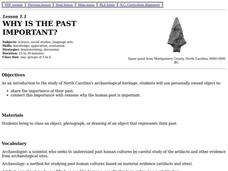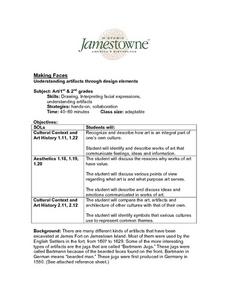Curated OER
Archaeology 2500: Texano Weapons
Students listen to oral story describing mystery artifact, work in groups to write descriptive report of artifact, and creatively form hypothesis based purely on misinterpretation. Students then explore and discuss difficulty of...
Curated OER
Artifact Bingo
Seventh graders participate in an artifact bingo game. Before beginning, they label the coordinates of a grid correctly along with symbols. They use the grid to place artifacts in their correct coordinates. They use primary source...
Curated OER
Tag It and Bag It: Archeology Lab Lesson
Seventh graders practice analyzing, collecting and categorizing artifacts. Using charts, they organize and interpret information about the artifacts they classified. They work together to create a graph to represent class totals and...
Curated OER
What Can We Learn From the Past?
Learners observe items from their past, making inferences and observations about their own culture based on these artifacts. Students then share with the class what they learned about their own culture, giving all learners more...
Curated OER
Artifacts 1: What Can We Learn From Artifacts?
students will learn about artifacts-what they are, how they are initially buried and then excavated. They participate in an online game and called "Stratigraphy" and participate in the "If Trash Could Talk" activity page.
Curated OER
Tea for Two
Students examine how certain items can link family and friends together in unique and interesting ways. They analyze how historic artifacts have helped people connect in the past by focusing on a silver teapot used by a family in the...
Curated OER
Explore the World: Create-Your-Own-Artifact
Students examine the cultures of different countries other than their own. They select a country they are interested in and research their lifestyles. Using clay, they create a model of one aspect of the new culture of their focus. ...
Curated OER
Searching the Attic
Students investigate an attic or basement to "discover" family artifacts. They develop a grid map using string, create a naming system for the grid, and analyze items of interest.
Curated OER
Learning from Artifacts Uncovering Clues, Large and Small
Students observe artifacts from Fort St. Louis at a website in order to make inferences about the people who lived there. They paint pottery in the style which might have been used by one of the cultural groups who inhabited the fort.
Curated OER
Classifying Artifacts
Students examine pictures of pottery and classify them. They work together to create a list of characteristics for each piece. They share their findings with the class.
Curated OER
A Museum as Time Capsule
Students focus on museum artwork and artifacts as resources to study history and geography.
Curated OER
Destruction in Bamiyan
Students examine the destruction of the colossal statues of Buddha, carved into sandstone cliffs of Bamiyan, Afghanistan, that were recently demolished by the Taleban. They look for photos of local artifacts that represent the culture...
Curated OER
Digging Deep
Students investigate the job description for archeologists and share their findings with the class. They research a current archeological dig and present their material to the class.
Curated OER
A Race Against Time
Pupils explore the act of preservation first in the process of preserving food and then in the preservation of historic sites, buildings, landmarks, and artifacts.
Curated OER
Why is the Past Important?
Fourth graders discuss the importance of North Carolina's archaeological heritage. They share with the class an object, photograph, or drawing of an object that represents their own or their family's past.
Curated OER
Site Robbers
Fourth graders interview a Native American and write a newspaper article or letter that expresses concern about robbing archaeological sites.
Curated OER
Four Ancient River Civilizations
Students explore how the environment shapes man, how man transformed his world, nd how art became part of the human process. The group is divided into clans and their migratory routes developed in the eight lessons of this unit.
Curated OER
"how To Think Like an Archaeologist" Suggested Pre-visit Activity for Historic Jamestowne
Students study grocery receipts to simulate the archaeological activity of classifying items. They discuss the receipts as if they were find lists.
Curated OER
Lesson 4: A Field Trip to the Maine State Museum
Students analyze the Maine State Museum's exhibit 12,000 Years in Maine. They create an artifact and write a description of that artifact that demonstrates their understanding of the way technology shapes culture.
Curated OER
Making Faces: Understanding Artifacts Through Design Elements
Students examine and discuss drinking container artifacts from Jamestown. They view images of the artifacts, discuss their purposes, draw an original facial expression for a brown paper jug, and write a description of the facial expression.
Curated OER
"How to Think Like an Archaeologist" - Suggested Pre-Visit Activity For Historic Jamestown
Learners examine how archaeologists use artifacts to explore other people and their cultures. They discuss types of artifacts, analyze receipts for clues, and discuss how what the items bought reflect about people.
Curated OER
The "Me" Exhibit
Students collects artifacts from home that they feel describe themselves. They write captions for each artifact and display them for their classmates.
Curated OER
Artifacts We Don't Dig Up
Students play a game of artifact show and tell using household items.

























